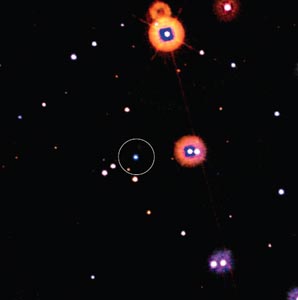Astronomers have reached another milestone in the understanding of gamma-ray bursts by observing a supernova at the location of an X-ray flash that was detected by NASA’s Swift spacecraft. The supernova was caught from the start of the explosion thanks to the X-ray flash precursor, an observation that sheds light on the link between X-ray flashes, gamma-ray bursts and supernovae.

Swift, the first spacecraft dedicated to observing gamma-ray bursts, is again making the headlines. Being able to turn its X-ray and optical-ultraviolet telescopes within a minute or so to the location of a new gamma-ray burst, it provides key information on the position of the burst and on the evolution of its early afterglow (see CERN Courier October 2005 p11). This has led to the identification of the host galaxies of a few short gamma-ray bursts, supporting the idea that short gamma-ray bursts arise from the merger of two neutron stars (see CERN Courier December 2005 p20).
The recent observation of a supernova associated with the X-ray flash detected by Swift on 18 February is the subject of a series of four papers published in Nature. S Campana and colleagues link features of the X-ray flash to the shock wave from supernova SN 2006aj, while E Pian and collaborators report on the optical discovery of the supernova and its association with the X-ray flash. SN 2006aj is the fourth supernova to be clearly linked to an X-ray or gamma-ray burst event. While the previous associations established the link between long gamma-ray bursts and especially luminous and powerful type Ibc supernovae (see CERN Courier September 2003 p15 and CERN Courier September 2004 p13), this new observation shows that X-ray flashes are also produced in similar core-collapse explosions of stars stripped of their outer hydrogen and helium envelopes. The papers in Nature analyse the link between the physical properties of the X-ray flash XRF 060218 and its associated supernova compared with the three other similar stellar explosions so far observed.
The emission of XRF 060218 was seen to peak in the X-ray region, at a lower energy than for typical gamma-ray bursts. Moreover, although the event lasted for as long as around 2000 seconds, it was about 100 times less energetic than typical gamma-ray bursts. The associated supernova was also much less powerful for this X-ray flash than for the three gamma-ray bursts. The inferred initial mass of the dying star is only about 20 solar masses, which is believed to be too small to form a black hole through core collapse. P A Mazzali and collaborators therefore suggest that a magnetar – a strongly magnetized neutron star – is at the origin of the X-ray flash on 18 February. This peculiarity would explain the sub-energetic properties of this event compared with other gamma-ray bursts thought to be powered by black holes.
The observation thus extends gamma-ray burst phenomenology towards smaller stellar masses than expected. The supernova associated with XRF 060218 has properties between those of a normal supernova of type Ibc that does not produce a precursor event and those powering a gamma-ray burst. This should allow a better understanding of why only some dying stars produce an X-ray flash or a gamma-ray burst. The detection of this X-ray flash was only possible because it was relatively nearby. According to A M Soderberg and colleagues, X-ray flashes should be about 10 times more common than long gamma-ray bursts, but most of them are too far away to be detected by current instruments.
Further reading
S Campana et al. 2006 Nature 442 1008.
P A Mazzali et al. 2006 Nature 442 1018.
E Pian et al. 2006 Nature 442 1011.
A M Soderberg et al. 2006 Nature 442 1014.








